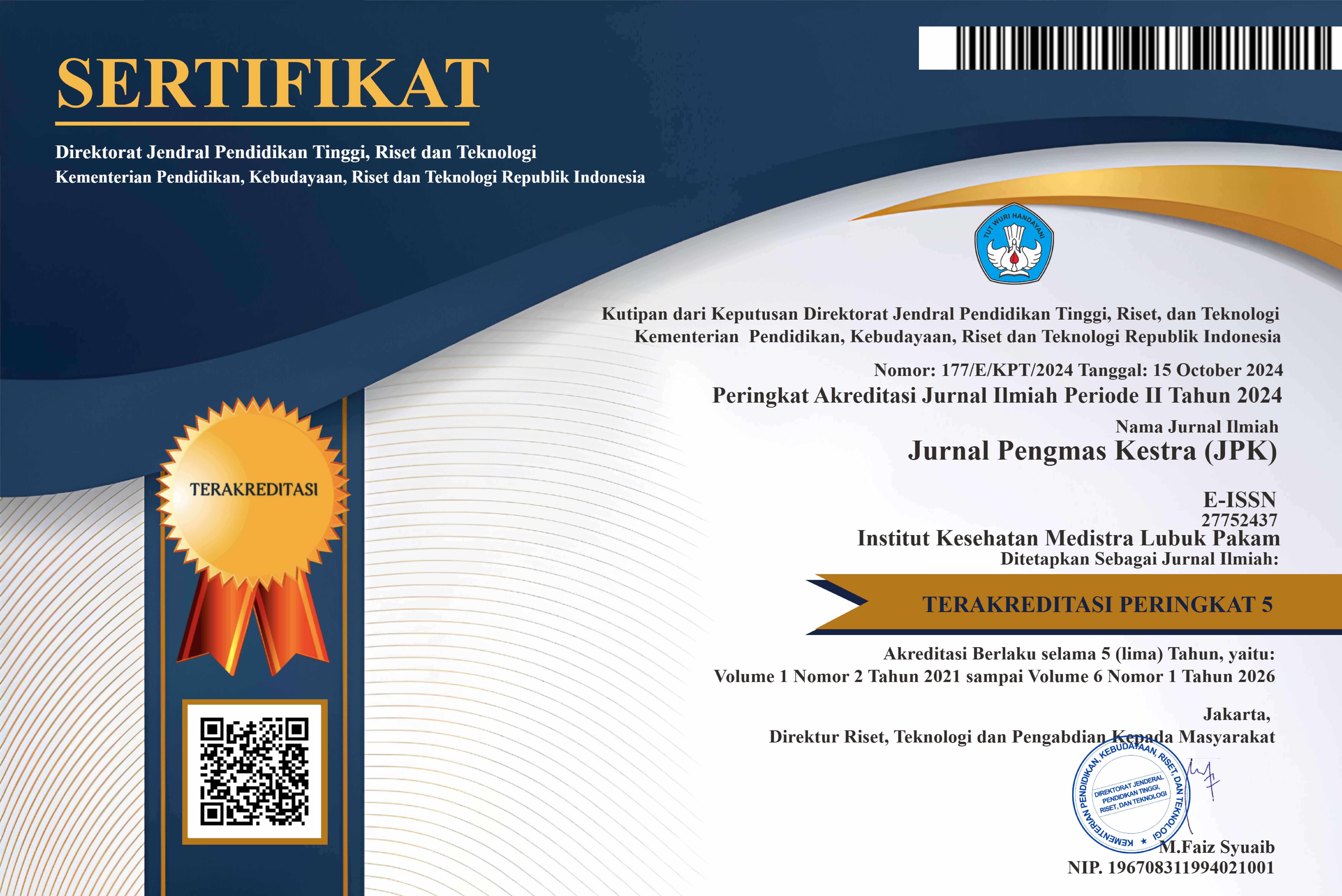CHEST COMPRESSION WORKSHOP BASED ON RULE OF FIVE ON DEPTH AND CHEST COMPRESSION FREQUENCY AT THE GRANDMED HOSPITAL IN 2022
CHEST COMPRESSION WORKSHOP BASED ON RULE OF FIVE ON DEPTH AND CHEST COMPRESSION FREQUENCY AT THE GRANDMED HOSPITAL IN 2022
DOI:
https://doi.org/10.35451/jpk.v2i2.1436Keywords:
Chest compressions; Rule of five; Depth and frequencyAbstract
Several measures to maintain life in cardiac arrest according to the American Heart, namely the application of a chain of survival, namely first aid when cardiac arrest occurs until treatment afterward. The rule of five is a rhythm calculation technique in chest compressions using the numbers 1,2,3,4,5, and 6 which adopts only 2 syllables. The purpose of this community service is to determine the ability of nurses to perform chest compressions based on the rule of five on the depth and frequency of chest compressions at Grandmed Hospital, Lubuk Pakam District, Deli Serdang Regency. The results of community service before being given a workshop show that nurses who perform chest compressions based on the rule of five to patients, namely all respondents have different percentage levels, namely good category as many as 7 people (23.3%), sufficient category as many as 14 people (46.7% ), and the less category as many as 9 people (30%). While the results obtained after being given a workshop show that nurses who perform chest compressions based on the rule of five to patients, namely all respondents have an increase in different percentage levels, namely the good category as many as 17 people (56.7%), the sufficient category as many as 9 people (30%), and the less category as many as 4 people (13,3%). The chest compression calculation system applied is the rhythm calculation system, namely and one, and two, and three, and four. If chest compressions are carried out properly and correctly according to the rules, compression pauses and consistency will create good tissue perfusion.
References
Andriaonto. (2019). Buku Ajar Kegawatdaruratan Kardiovaskular Berbasis Standar Nasional Pendidikan Profesi Dokter 2019. Airlangga University Press.
Angkejaya, O. W., Pattiasina, B., Matakupan, M., & Ohoiulun, A. (2018). pelatihan bantuan hidup dasar ( basic life support ) bagi mahasiswa universitas pattimura pada pandemi covid-19 basic life support training for pattimura university student amid covid-19 pandemi. 2(1), 32–37.
Darmawan R E, & Oktavianus. (2013). Pengaruh kompresi dada berdasarkan Rule of Five terhadap kedalaman dan frekuensi kompresi dada. Kesmadaska, 4(1), 47–56.
Di, J., Igd, R., Mardi, R. S., & Sragen, L. (2020). 2) , 3). 2020(25), 2011–2020.
Farida Juanita dan Suratmi. (2017). Proceeding of Surabaya International Health Conference ( BLS )
Jantung, H., & Kehidupan, D. I. (2021). Akademi Keperawatan Husada Karya Jaya. 7(2), 21–24.
Lubis, B., Amelia, P., Nafiah Nasution, A., Silvanni Nasution, M., & Nasution, S. (2021). Promotive and preventive programs about basic life support in Medan Barat district. ABDIMAS TALENTA: Jurnal Pengabdian Kepada Masyarakat, 6(1), 40–45. https://doi.org/10.32734/abdimastalenta.v6i1.5104
Neumar, Robert W., et all. (2015). 2015 AHA Guidelines update for CPR & ECC. In American Heart Associationtion (Vol. 132, Issue 18).
Notoajmodjo. (2017). Metedologi Penelitian Kesehatan. Renaka Cipta.
Notoatmodjo dan Sukitdjo. (2010). metodologi penelitian kesehatan. Rineka Cipta.
Perawat, O. M. (2021). Stayin alive”. 8(1), 49–58.
Resmana Lim, & Lang Jiwa Noventra. (2018). Alat Resusitasi Jantung Paru. Kendali Suara Berbahasa Indonesia Untuk Automasi Rumah Tinggal, 11(1), 1–6. https://doi.org/10.9744/jte.11.1.1-6
Sulistyorini, Setianto, B., & Hasina, S. N. (2020). Evaluasi pengetahuan basic life support (bls) pada petugas non medis setelah mengikuti pelatihan bls. Jurnal Keperawatan, 12(2), 231–240.
Yasin, D. D. F., Ahsan, A., & Racmawati, S. D. (2020). Pengetahuan Remaja Tentang Resusitasi Jantung Paru Berhubungan Dengan Efikasi Diri Remaja Di Smk Negeri 2 Singosari Malang. Care : Jurnal Ilmiah Ilmu Kesehatan, 8(1), 116. https://doi.org/10.33366/jc.v8i1.1751
Downloads
Published
Issue
Section
License
Copyright in each article is the property of the Author.




















